Introduction
Canada’s financial system emerged almost 20 years ago. What happened? Majority of Canadians would give much recognition to the remarkable change on the shortfall in the last 5 years. Canada finally started living within their means; created room for tax reduction; and began relying more on industrialists and less on administrators.
People who track economic concerns more closely would in addition give credit to the Canadian bank’s fight against inflation, concluding with the “purging” inflation of the late1980s. Credit would in addition be granted to the extensive relaxation of commerce after adoption of the United States-Canada Free-trade Treaty in 1990, and afterwards the N. American Free-trade Treaty (Nicholson 4).
Those unwilling to associate economic performance with policy would just say that rising tides lift all ships. Those rising tides comprised remarkably positive international macroeconomic events; the investment rise elicited (illogically or not) through the promising information systems; and the unusual enthusiasm of the U.S, from which Canada profits in excess of all other nations.
All focused on making positive Canadian expansion unavoidable. But most of the Canadians in the association of progressed economy – particularly the affiliate nations of the Organization of Economic Cooperation and Development (OECD) – have not done quite good.
And focusing on various aspects that are likely to be main drivers of stable financial development – for example, investment in both natural and mankind assets; novelty; the condition of local rivalry; success of money markets; elasticity of labor structures; industrial performance – people see that Canada has turn into, in most opinions, well-placed for maintaining the pace developed in the early 1990s.
This report focuses on outlining the case for this assertion. The viewpoint is policy-based, as opposed to academic. While I draw on numerous references – most of which have been peer reviewed – the basic source is the OECD’s Economic Performance Plan developed at the interest of affiliate states in 1998.
The report presents economic performance of Canada for the last 10 to 20 years based on the findings of the OECD’s inclusive study of the main drivers of stable economic development.
This global evaluation is complemented utilizing a broad variety of Canada-based information, objectively selected as an indication of what Canadians have been performing correct (or incorrect). Generally the report is based on the domestic data and not on any particular indicator.
Growth of Canada: A Historical View
All through the past-war era until the beginning of the 1990s, Canada experienced a continued era of huge expansion in per capita production, bigger on average compared to that of the US. It was an era when per capita development in Canada, W. Europe, and in particular Japan, moved toward that of the U.S and joblessness levels were comparatively small.
This cheerful moment came to a stop during the “energy calamity” in the late 1980s creating room for weakening development and increasing financial crisis – an international stagnation. Indications of a continued recuperation of per capita increase – in particular in the U.S, but also in other nations like Canada and Finland – did not emerge until 1990s, and are yet to emerge in most of European nations.
It is untimely to determine if this “emerging market” returns – caused at first by the introduction of new technologies, specifically in Canada and Sweden, but currently more and more associated with efficient applications of ICT-oriented systems in the market in general – will generate ongoing output increase of the quantity lately witnessed (Jorgenson 6).
Economic performance of Canada has been widely in line with the overall situation simply illustrated – i.e. unusually well-built average increase of productivity in the 1990s, followed by a predominantly dreary growth for the next 15 years, and lastly a remarkable regain after 2005, with middling increase in 2006 outdoing both the Europe and the U.S (fig. 1).
Lagging financial growth of Canada from 1990 to 2005 – and the related economic decline and increasing gap compared to United States output – has loaded the nation with a reputation for second-level financial growth that has tested difficult to bring down. But five years after emerging from crisis, a more exciting perspective for the Canada’s market is justified (Robidoux 48).
Canada’s living standards, compared to GDP per capita, rates second in the G-7 below the U.S and approximately in the same rank with a set of bigger rich OECD nations comprising Denmark and Switzerland as indicated in figure 2.
But a difference of about 15% compared to the U.S. For Canada, this is the appropriate point of reference. In fact, for people visiting or purchasing goods in the U.S, the difference appears even bigger based on the constantly fragile Canadian dollar, the equivalent amount of which has been significantly low – by almost 25% – compared to its buying influence similarity index on which the information presented in figure 2 is based.
Figure 1: Growth of Canada has Recuperated Strongly (Average Yearly increase in GDP per capita)
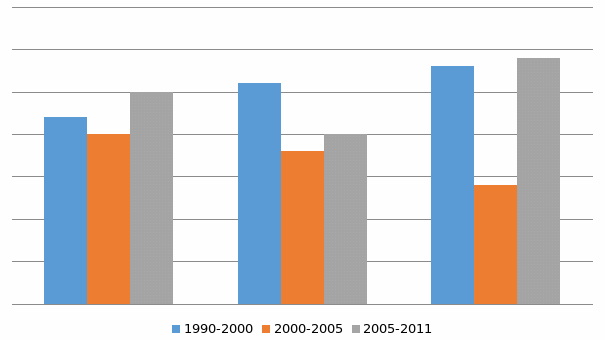
Source: Nicholson 5
Figure 2: International View on Living Levels (Compared to GDP per capita* FY 2011)
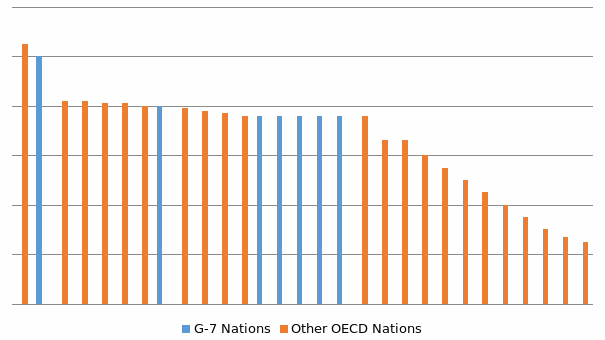
Source: Nicholson 5
Economic Performance: GDP
Canada came out of the financial crisis toward the beginning of second half of 2008 and economic performance recommenced beginning in the fourth quarter of 2009 fiscal period (figure 3). Since then, the economies have witnessed 6 repeated quarters of economic increase until the end of 2011. In 2010, actual GDP increased by 2.9 %, equalizing the 2.3 % decrease recorded in 2009.
Focusing on the overhead-oriented kinds of GDP (figure 4), increase in actual individual expenditure overheads on products was a bit greater compared to total expansion in gross domestic product, as consumption increased by approximately 3.5 % in 2010 following a growth of about 0.5 % in 2009 (Miller 23).
Figure 3: Canada’s Actual GDP Increase, 2006 to 2010
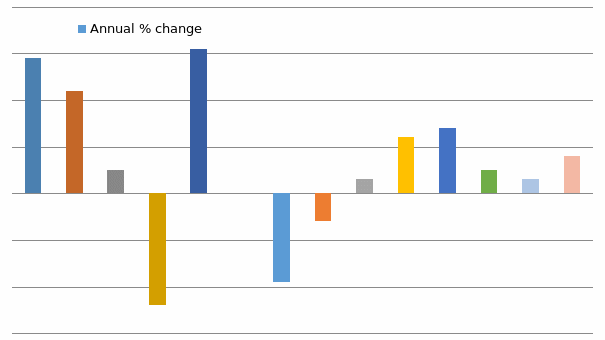
Source: Nicholson 4
Actual spending on nonperishable, semi-perishable, and perishable increased by 5.3 %, 4.9 %, and 1.8 % in that order, while spending on services advanced by 3.5 %. Spending increased widely, with a few exemptions: spending on energy, except that associated with motor fuels, declined in 2010, together with spending associated with learning and leisure deliveries, miscellaneous individual needs, and tobacco goods.
Expenditures advanced most for spending overseas (26.1 %); females’ attires (10.7%); second hand and new vehicles (6.4 %); shoes (6.6 %); and fixtures, floorings and other accessories (5.3 %). With the advanced expenditures, individual spending contributed slightly more than 2.1 % to actual GDP increase in the 2010 fiscal year, up from 0.3 % in 2009 (Miller 48).
Figure 4: Contribution to Actual GDP Increase, 2007 t0 2011
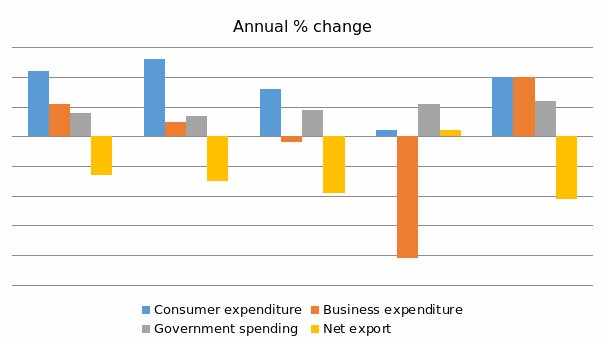
Source: Jorgenson 17
Actual business investments advanced 7.2 % during 2010 fiscal year, following a decline of 16.2 % in 2009. Investments in fixed assets recommenced after 24 months of decrease, increased to 11.3 % during 2010 fiscal year. Computers, telecommunication equipments, factory machines, and automobiles all experienced two-digit levels of growth to set the pace.
Investments in industries declined by 0.6 %, since a 1.4 % growth in investments in technology designs were inadequate for offsetting a 4.9 % decrease in investments in the construction industry. Investment towards housing, which comprises new buildings, re-selling, and reconstruction operation, grew by 10.5% during 2010 fiscal year after 3 years of reduction.
New residential buildings advanced 15.3 % in reality, and repair operation recorded an increase of 10.8 %, while re-selling operation declined by 1.8% (Robidoux 46).
Firms were dynamically refurnishing stocks in 2010 since there was an average $7.8 billion growth to the stocks for non-agricultural operations. Similarly, agricultural inputs were down by an overall $341 million compared to 2009.
Generally, business operations contributed additional 2.1% positions to financial development during 2010 fiscal year, following a reduction of 4.2% positions from 2009 economic growth. Business investments were responsible for the bigger percentage of the growth, at almost 1.4%, whereas re-stocking was responsible for 0.9% of the growth (Robidoux 49).
The quantity of imports and exports advanced 13.3% and 6.5%, in that order. Generally, the growth of actual exports contributed 1.9% positions to real GDP during the 2010 fiscal year while the growth of actual imports took away 4.1% positions from economic scorecard in 2010. Accordingly, trade hampered growth over the 2010 fiscal year, taking away total 2.3% positions from economic performance of the year.
Generally, the quantity of exports advanced $26.8 billion based on 2002 statistics. The vast contribution (96.9%) to the growth in terms of exports during 2010 fiscal year was as a result of exporting goods, with almost 81.1% of the growth associated with motor vehicle accessories ($21.2 billion).
Similarly, at 87.3%, the larger share of the growth in imports originated from fixtures, led by heavy equipments and machines ($21.9 billion), motor vehicle accessories ($18.7 billion), and engineering inputs ($12.4 billion).
Overall, the amount of products imports advanced $56.9 billion based on 2002 statistics against 2009 standards. Services side recorded $8.9 billion based on 2002 statistics, led by transport sector, growth of $6.1 billion, and travel, growth of $2.9 billion (Nicholson 18).
Findings
The turnaround in actual GDP at the state standard was reflected on regional outputs, as productivity increased in each region and sector. However, area differences were evident: Nova Scotia and Manitoba recorded expansion lower than the national rate. On the contrary, Labrador and Yukon, the N.W regions, and Quebec all posted slightly greater averages of economic growth compared to the nation average (figure 5).
In Newfoundland and Nunavut, economic productivity increased 6.1% in 2010, after having 11.3% reduction in 2009. These were the greatest paces of growth among the regions. The growth was linked to mining activities, particularly by a 33.9% growth in metal ore extraction coupled with advanced productivity in oil mining.
Production in housing sector advanced 18.8% and operation started on a newly constructed mineral factory. Advanced products in rotation resulted in advanced operation in retail business and transport sector.
Industrial production during the 2010 fiscal year was slightly altered than in 2009 (grew 2.9%) since growth in marine products preparation (up 16.9%) was partly offset through reductions in electric appliance processing (down 41.2%).
In Manitoba, production increased by 1.9% in 2010, after having 0.3%, 0.5%, 0.1%, and 0.2% reductions in 2008, 2009, 2010, and 2011 respectively. Housing sector and agricultural output advanced, while extra capability led to increased production through increased efficiencies.
Investment and indemnity, wholesale business, public management, and health sectors in addition added to the total growth. But productivity in engineering dropped by 7.9% in 2009, as foodstuff, automobiles and chemical items recorded reductions (Nicholson 12).
Figure 5: Actual GDP Performance by Region, 2010
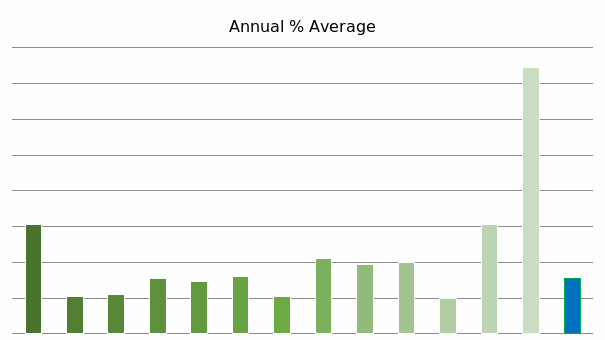
Source: Nicholson 5
In Prince Edward region, actual GDP advanced by 2.3% and 2.2% in 2008 and 2009 respectively following reductions of 0.4% and 0.3% in 2008 and 2009 in that order. Achievements in processing, housing, retail business, and travel sectors balanced reductions in mineral and petroleum mining and in sundry manufacturing sector.
In processing, travel equipment dealers advanced production, particularly in Coastal Guard boats. Productivity for producers of rubber in addition advanced, as well as that for seafood products and textile sector (Macdonald 499).
Discussion/ Conclusions
Human Asset
There are basically more to mankind asset formations compared to periods of training. Working place coaching and long-lived training carried out by a person on his/her own behalf vividly increases and updates human asset.
However, the most compelling effect could be the pre-primary and post-primary setting where permanent capabilities can be improved or destroyed. There are reliable evidences that timely intervention for mitigating demerits has greatly bigger reward compared to later trials during remediation (Miller 112).
Natural Asset
The quantity and level of investments toward industrious asset are the most popular and strong driver of production expansion. Its effects are through two basic avenues: capital expanding in which production per employee is enhanced just through more financing per employee – tractors are normally better compared to hoes; and the customization of industrial novelty in emerging forms of financing – microchip application being the most important current case.
Evidently, funds do not come free and over-financing leaves them “unaccounted”, nonproductive application at minimum for the whole fiscal year (e.g. millions of meters of unused optical fibers). The practice problem is in creating a finest environment for investors in order that privately-owned firms are encouraged in extending investment whereby both private and, basically, socio-economic gain exceeds expenditure (Jorgenson 4).
Effective macroeconomic guidelines, comprising tax policy, are obviously major contributors to a favorable investment environment. But so is organizational administration policy associated, for instance, with innovation rights, business rivalry, labor economy guidelines, and abroad investments, in addition to corresponding supply sector investment by state, for example, in roads, training and research.
Business regulation can as well have a significant effect through the complementarities often seen between business liberalization and advanced investments, either in taking benefit of increased chances or in meeting fresh rivalry. Public regulation in regard to secure and effective monetary organizations is as well required in ensuring that funds are effectively directed to investment along the whole range of uncertainty.
Superimposing all of these particular incentives is the desire in minimizing risk by developing guideline transparent and as conventional as possible as capital investment constantly entails more permanent dedications (Nicholson 16).
Trade Exposure
Advanced business experience seems to be a possibly possible cause of increased output, indicating growth from relative benefit and the chance of exploiting large markets (i.e. specialization in serving an international economy), and the drive for novelty resulting from experience to tougher rivalry and highly quick acceptance of good policies for domesticating manufacturers.
While Canada may keep on gaining from improved business liberalization, there is a limit with respect to the current level of sincerity and the country’s previously remarkably great extent of business operation as illustrated in figure 6.
Inflation in Canada
Possibly the most astonishing inference of the OECD evaluation is the approximated power of the effect of economic slowdown, not only in the degree but also in the variability of prices. Lowering the degree of inflation seems to influence development greatly through enhancing the business investment environment.
Regrettably, the capability of price control in spurring additional development in Canada and other OECD nations has been exhausted. In fact, reduction has really turned out to be an issue in some regions (Jorgenson 5).
Figure 6: Increasing Oversea Business Experience (Av. of imports/exports)
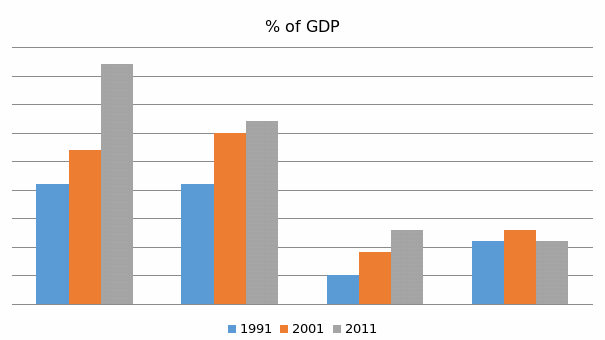
Source: Nicholson 18
Summary
Economic performance of Canada on side of capital financing has been high, but not great compared to other OECD affiliates, so a second ranking. It continues to be viewed if the investments by Canada’s organizations in technology in the last decade, while less compared to that of the U.S, can however have been effectively distributed.
Issues have in addition been articulated concerning the evident reduction of share of Canada in international foreign direct investment (FDI) between the last quarter of 1990s and late 2010s, whereas the previously primary share as a result of the growth in U.S. Ranking of Canada in terms of novelty is ambiguous.
Pointers have been enhancing in complete conditions, but less thus in comparative conditions. It has to be understood that rising output is not a stop in itself, but instead the financial modes by which the wellbeing of the whole country can be enhanced.
Works Cited
Jorgenson, Stiroh. “Lessons for Canada from the US Growth Resurgence.” International Productivity Monitor 6.2 (2003): 3-18. Print
Macdonald, William. “Real Gross Domestic Income, Relative prices and Economic Performance across the OECD.” Review of Income and Wealth 56.3 (2011): 498-518. Print.
Miller, Paul, and Y. Lee. Literacy, Numeracy and Labor Market Success, Canberra: Department of Education, 2011. Print.
Nicholson, Peter. “The Growth Story: Canada’s Long-run Economic Performance and Prospects.” International Productivity Monitor 7.3 (2011): 3-23. Print.
Robidoux, Wong. “Has Trend Productivity Growth Increased in Canada?” International Productivity Monitor, 6.1 (2010): 47-55. Print.